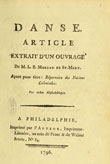Culture
Saint Domingue developed a rich and expressive culture as its economy flourished.
Like most places with a thriving economy, Saint Domingue witnessed the growth of a lively culture in the eighteenth century. Cap Français (now Cap Haïtien) had more people than Boston, and as the historian James McClellan wrote, “the quality and diversity of life in Cap François, for a privileged minority at least, largely matched anything offered in Havana, Philadelphia, New York or Charleston.” The largest theater held 1500 people; one in Port-au-Prince held 750; smaller ones in Léogane and St. Marc held 400. Orchestras and operas thrived in cities, and music was heard everywhere in the colony, in every type of household. African music was especially prevalent, and was described in books about Saint Domingue, including the definitive works written by Moreau de Saint-Méry. A busy print culture established itself in the eighteenth century, issuing respectable government edicts, highly-informative newspapers and even the occasional bawdy novel. In all of these respects, Saint Domingue depended on French precedent, but it also was very much a place of its own. The Creole language that developed included Africanisms and local expressions – as Moreau de Saint- Méry wrote, “there are a thousand little nothings that one wouldn’t dare to say in French.”

